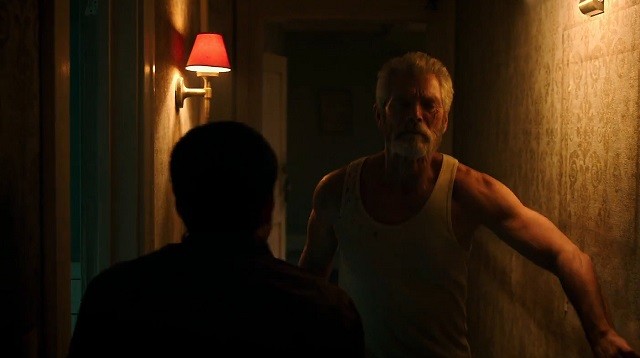25 years ago, The People Under The Stairs injected new life into the Escape The Dungeon horror movie by playing with the immorality of capitalist economics and race relations. At the time, Wes Craven was making a movie about rent-gouging landlords who hoard money while raising rents to keep the poor impoverished. In order to escape the cycle of poverty, our protagonists, two impoverished black men, go out on the mission to rob the rich by invading their house. Back in 1991, just as America was coming to grips with the economic inequality left by Reaganomics, the message of stealing back our money from the morally bankrupt landlords seemed positively radical.
Don’t Breathe takes the basic concept of The People Under The Stairs, but gives it another twist. In an abandoned Detroit neighborhood (home of all movies about economic impoverishment), a Veteran of the Iraqi War (Stephen Lang), blinded by grenade shrapnel, lives all by himself after his daughter was run over by some rich girl who didn’t even do time. This guy is virtually a shut-in, rarely leaving the house except to walk his guard dog Rottweiler, not that there’s anybody in the neighborhood to notice. Then three poor kids, assuming he has stashed his money somewhere in the house, decide to rob him and he has to make a stand. That’s when things get icky.
Like The People Under The Stairs, Don’t Breathe follows the thieves as they try to invade the home of this “rich” miserable military vet. Two of the thieves have a complete backstory – Rocky (Jane Levy, Evil Dead) comes from a broken home with an abusive drug-addicted mother, Alex (Dylan Minette, Goosebumps) has a lower-middle-class existence – to “justify” their robbing a blind dude. Even though he fleshes out the character’s backstory to understand why they would do such a heinous act, writer-director Fede Alvarez knows full well that what the three are doing isn’t right, isn’t justified, and is morally bankrupt. That moral bankruptcy is what separates Don’t Breathe from The People Under The Stairs.
The Blind Man, as they say in the film, is no saint. By the end of the film, he commits many despicable acts; but, when he’s first robbed by the three hooligans, he has done nothing to the thieves. Alvarez doesn’t give us a safe ground to stand on, forcing the audience to choose between a mean blind old veteran of an unpopular war and a group of thieving teenagers who can’t even get a job. By preventing us from sympathizing with the thieves, Alvarez gives himself permission to have the characters act as unpleasantly as possible, foiling audience expectations. Not only do we not know what’s coming around the next corner, we don’t even know what we want to come around the next corner. Should the kids get away with the (quite possibly uninsured) money or should the The Blind Man bring them to justice?
Though maybe a touch reliant on jump scares, Alvarez ratchets the tension for well over an hour, creating an atmosphere of dread and disgust. There is one caveat, and its a doozy. There is a late movie violation that comes out of left field which is probably a deal breaker for many many people. That scene is grotesque, gratuitous and reeks of effort. Compared with the mastery of tone before and after it, that scene is, perhaps, one step too far (omg, did I actually write that?). If you can ignore that flaw, and Dylan Minnette’s slightly over the top facial expressions, Don’t Breathe delivers an intense thriller that leaves you feeling dirty as the credits roll. That’s how a horror should be.

